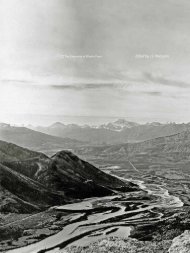C Ihe Ladies c cu. V'VVAN - History and Classics, Department of
C Ihe Ladies c cu. V'VVAN - History and Classics, Department of
C Ihe Ladies c cu. V'VVAN - History and Classics, Department of
- No tags were found...
Create successful ePaper yourself
Turn your PDF publications into a flip-book with our unique Google optimized e-Paper software.
244 Notes to Pages 22-23,201efforts to reach the top <strong>of</strong> some ridge, the engine wouldstop with a loud despairing snort, then the conductorwould apologetically ask all passengers to please jump <strong>of</strong>f<strong>and</strong> walk in order to reduce the load.After backing up a couple <strong>of</strong> miles the engine wouldcorne swaying along, puffing <strong>and</strong> wheezing mightily, <strong>and</strong>finally top the hill. "All aboard" some overalled trainmanwould yell <strong>and</strong> we would jump on once again. Ere long thetrain would corne to another stop-a clay-<strong>cu</strong>t-<strong>and</strong> eachpassenger would have to take hold <strong>of</strong> the business end <strong>of</strong> ashovel <strong>and</strong> help remove a few tons <strong>of</strong> clay <strong>and</strong> earth whichhad fallen in upon the track. (Arctic 179-80)At the railway station there was quite a crowdAccording to Dorrien Smith's field note for IJune, RichardBonnycastle <strong>and</strong>J ohn F. Moran numbered among those whoboarded the train with them, while the well-wishers includedBishop Gray, his family, <strong>and</strong> Miss Ferguson. Arriving in thecity in 1895, Henry Allen Gray served as the first Anglicanbishop <strong>of</strong> Edmonton from 1914 to 1931. Dorrien Smith's fieldnote for 31 May mentions visiting Mrs Gray at their horne,10049-103 Street.the immensely long trainThe size <strong>of</strong> the train is perhaps attributable to the fact that 1926marked the first year the HBC decided to "re-route their 'WestArctic Trade Goods' via Waterways ... instead <strong>of</strong> sending themvia Bering Strait" (Hatcher, Volume 2 7). Sherwood Plattcounted fifty-two cars when he boarded the train on 6 July1926 (6). Waterways was the terminus <strong>of</strong> the railway line aboutthree kilometres southeast <strong>of</strong> Fort McMurray. It was the transshipmentpoint at which goods going north in the summerseason were transferred from rail to steamer <strong>and</strong> barges on theAthabasca River (Mardon 204). Although she does notmention it in her book, Vyvyan did visit Fort McMurray whilewaiting at Waterways. Originally a NWC post ab<strong>and</strong>oned sometime after 1821 due to a smallpox epidemic, Fort McMurray wasrebuilt by the HBC in 1870 <strong>and</strong> named after HBC factorWilliam McMurray. It functioned as a fur trade post <strong>and</strong> transportationcentre connecting Edmonton <strong>and</strong> the Athabascadistrict. Before the railway, travellers <strong>and</strong> freight travelled bywagon road from Edmonton to Athabasca L<strong>and</strong>ing, <strong>and</strong> thenceby barge down dangerous sets <strong>of</strong> rapids on the Athabasca Riverto Fort McMurray. Once the railway arrived, the town reliedfor its existence on the Lake Athabasca fishery, salt extractionfrom the nearby salt plains, <strong>and</strong> its location near the Waterwaystransportation point (Cooke 99-102).Field NoteforSaturd'!J 29 M'!JW.W. Cory Deputy Minister <strong>of</strong> Dept. <strong>of</strong> the InteriorWilliam Wallace Cory assumed the <strong>of</strong>fice <strong>of</strong> commissioner <strong>of</strong>the NWT in 1918 (Fumoleau 155). (The territorial commissioner'srole resembled that <strong>of</strong> provinciallieutenants-governor. )Field Note for Sund'!J 30 M'!JMiss Ferguson Bishop Gray's governess came to lunch withusDorrien Smith's field note for this date identifies MissFerguson as a friend <strong>of</strong> Dorothy Dashwood, their hostess onVancouver Isl<strong>and</strong> at the end <strong>of</strong> the trip.CHAPTER 5: LURE OF THE NORTH (1-5 JUNE)The book takes on a different style in this chapter's use <strong>of</strong> thepresent tense, creating a sense <strong>of</strong> timelessness lacking in bothwomen's field note entries, which are full <strong>of</strong> concrete detailsabout people <strong>and</strong> places, <strong>and</strong> daily information, such as thesteamer's navigation <strong>of</strong> the river's varying course by having the"1/2 breed" mate take soundings from a canoe (4June). At theend <strong>of</strong> the chapter, this information is embellished with physicaldescription <strong>and</strong> transformed into the image <strong>of</strong> the matesilhouetted against the water, frozen in Vyvyan's memory <strong>and</strong>embodying the significance <strong>and</strong> triumph <strong>of</strong> the (white)pioneers <strong>of</strong> the North. Generally, the movement from fieldnotes to book follows this pattern during the steamer journey,omitting some <strong>of</strong> the facts <strong>and</strong> information, <strong>and</strong> imbuing thebook with an impressionistic sense <strong>of</strong> the timeless <strong>and</strong> endlessspace <strong>of</strong> the northern wilderness. Also evident throughout thebook (<strong>and</strong> not the field notes) is Vyvyan's retrospective evaluation<strong>of</strong> herself <strong>and</strong> Gwen as tourists, "fair game to those men <strong>of</strong>the North who love to spin a yarn to the ignorant" (23).the French-Canadian judge. going to Aklavik to preside atan Eskimo murder trialVyvyan's field notes clarify that this judge was Lucien Dubuc(1877-1956; "Chief'), the stipendiary magistrate for the NWT
















